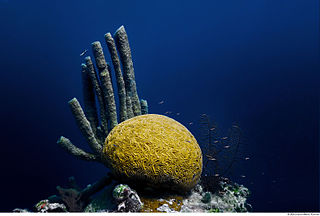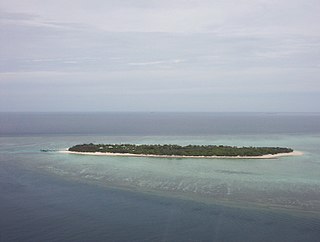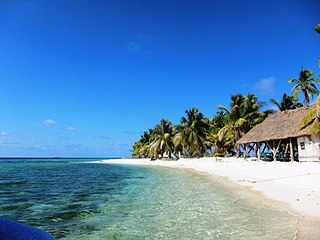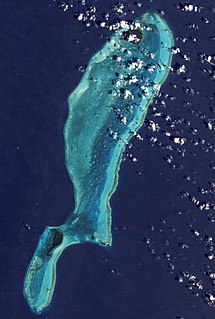| Look up barrier reef in Wiktionary, the free dictionary. |
A barrier reef is a type of coral reef formed offshore. It may also refer to:
- Specific barrier reefs, including the
- Belize Barrier Reef, straddling the coast of Belize, within the Mesoamerican Barrier Reef System
- Great Barrier Reef, in Australia, the world's largest coral reef system
- Mesoamerican Barrier Reef System, which covers over 1000 km from Isla Contoy at Yucatán Peninsula to Belize, Guatemala, and the Bay Islands of Honduras
- New Caledonian barrier reef, in the South Pacific

The Belize Barrier Reef is a series of coral reefs straddling the coast of Belize, roughly 300 meters (980 ft) offshore in the north and 40 kilometers (25 mi) in the south within the country limits. The Belize Barrier Reef is a 300-kilometer (190 mi) long section of the 900-kilometer (560 mi) Mesoamerican Barrier Reef System, which is continuous from Cancún on the north-eastern tip of the Yucatán Peninsula through the Riviera Maya and up to Honduras, making it the second largest coral reef system in the world after the Great Barrier Reef in Australia. It is Belize's top tourist destination, popular for scuba diving and snorkeling and attracting almost half of its 260,000 visitors. It is also vital to the country's fishing industry.

The Great Barrier Reef is the world's largest coral reef system composed of over 2,900 individual reefs and 900 islands stretching for over 2,300 kilometres (1,400 mi) over an area of approximately 344,400 square kilometres (133,000 sq mi). The reef is located in the Coral Sea, off the coast of Queensland, Australia. The Great Barrier Reef can be seen from outer space and is the world's biggest single structure made by living organisms. This reef structure is composed of and built by billions of tiny organisms, known as coral polyps. It supports a wide diversity of life and was selected as a World Heritage Site in 1981. CNN labelled it one of the seven natural wonders of the world. The Queensland National Trust named it a state icon of Queensland.

The Mesoamerican Barrier Reef System (MBRS), also popularly known as the Great Mayan Reef or Great Maya Reef, is a marine region that stretches over 1,000 kilometres (620 mi) from Isla Contoy at the tip of the Yucatán Peninsula down to Belize, Guatemala and the Bay Islands of Honduras. The reef system includes various protected areas and parks including the Belize Barrier Reef, Arrecifes de Cozumel National Park, Hol Chan Marine Reserve (Belize), Sian Ka'an biosphere reserve, and the Cayos Cochinos Marine Park. Belize's coastline, comprising the Belize Barrier Reef, is home to approximately 80% of MBRS. The Belize Barrier Reef is the largest barrier reef in the northern hemisphere and the second largest barrier reef in the world. The Belize Barrier Reef and Belize's three offshore atolls, several hundred sand cays, mangrove forests, coastal lagoons and estuaries—collectively termed, the Belize Barrier Reef Reserve System—has been designated a World Heritage Site by UNESCO (1996).
- Television series
- Barrier Reef (TV series), an Australian television series
Barrier Reef was an Australian television series that was first screened in 1971.
| This disambiguation page lists articles associated with the title Barrier reef. If an internal link led you here, you may wish to change the link to point directly to the intended article. |










